Chapter 7. Following the flooding cycles in the Amazon rainforest Fishing, chagra and forest food system of the Tikuna, Cocama and Yagua peoples in Puerto Nariño, Colombia
Section 1 Community and food system profile
1. GEOGRAPHIC CONTEXT
The large biome of the Amazon basin, with 7.4 million km2 shared by Brazil, Bolivia, Colombia, Ecuador, Guyana, French Guiana, Peru, Suriname and Venezuela, represents the equivalent of 4.9 percent of the world’s continental area. The vast Amazon basin is home to the largest expanse of tropical rainforest on the planet, great ecosystem diversity and important water resources. The Amazon River runs nearly 7 000 km and has an extensive network of tributaries consisting of more than 1 100 rivers. Such characteristics make it guarantee approximately 20 percent of the volume of freshwater on the planet. Currently, more than 34 million human beings live in the basin, of which only 3.5 million are indigenous. This demography implies great challenges to ensure sustainable economic development and conservation of this great biome. Colombia has a surface area of 2 070 08 km² made up of 1 141 748 km² of continental area and 928 660 km² of maritime area. It is considered a mega-diverse country boasting a great wealth of species and ecosystems. The Colombian Amazonian region encompasses 483 163 km², which represents 42.3 percent of the country’s continental territory (Instituto Amazónico de Investigaciones Científicas, 2018; Alonso et al., 2007).
This research was conducted in Puerto Nariño, the second municipality of the Amazonas Department, in the southwestern part of the “Colombian Amazonian Trapeze”, on a high tierra firme terrace. The municipality is located on the left bank of the Loretoyacu and Amazon rivers, between the coordinates 03°54’ - 03°12’S and 70°17’ - 70°42’W. It borders Peru to the northwest and south, and the municipality of Leticia to the east – situated 87 kilometres away. It is only accessible via the river. Puerto Nariño has an area of 1 704 km2, of which only 2 km2 are urban, 1 406.23 km2 comprise the reserve, and 296 km2 correspond to the forest reserve. The Tikuna-Cocama-Yagua (Ticoya) indigenous reserve is located in Puerto Nariño and inhabited by people belonging to these three Indigenous Peoples, from which the reserve takes its name. The population is distributed amongst 22 communities located on the banks of rivers or lakes, on flood plains and on tierra firme areas, with most of the settlements located in the area that is reserve territory. The Tikuna are one of the largest populations in the area called the “Colombian Amazonian Trapeze” to the south of the Amazon.
The climate is hot and humid. The average annual temperature is 26 °C. During the summer, it could reach a maximum temperature of 38 °C. During the middle of the year, it could reach a minimum of 13 °C when the southern winds arrive during the period known as friaje. The average altitude is 40 metres above sea level, the relative humidity is 87 percent, and the average annual rainfall is 3 200 mm per year (Rangel and Luengas, 1997).
The amount of rainfall determines four hydrometric periods in the aquatic environments. The period of high waters, from February to April, corresponds to the time when the forest is most flooded, and the lake system is connected to the rivers. During the falling waters period, between May and July, the water flows from the plains, lakes and canals towards the river. The time of low waters between August and October is characterised by the decreasing level of water and a change of its composition due to activation of organic matter decomposition processes. This period is then followed by the time of rising waters, from November to January, during which lakes, plains and rivers begin to flood as a consequence of rainfall happening in the Upper Amazon.
The municipality is located in a tropical rainforest area, in which three types of forests have been identified. The first is the tierra firme forest,33 which is not subjected to flooding cycles. The second is the várzea forest, which is subjected to periodic flooding by whitewater rivers. The third is the swamp or igapó forest, which is subjected to seasonal flooding by blackwater rivers (Trujillo and Duque, 2014). Puerto Nariño is located where the Lagos de Tarapoto Wetlands Complex is found. It corresponds to a river plain formed by the Amazon River and its confluence with the Loretoyacu River, in addition to a wetland system. This wetland is located in the lower area, with annual water-level variations of up to 14 metres. It comprises 21 lakes: Tarapoto Largo; Tarapoto Redondo; Cabezales 1, 2 and 3; Chimbillo; Chullo; Airuwé 1 and 2; Soledad; El Correo; San Juan del Socó; Chepetén; Mihuá; Mariano Cocha; Calzón Cocha; Cocha Larga; Garza Cocha; Charapacocha; Yolvino and El Sapo. The ecological and cultural importance of this area has been recognised at the international level with the designation of the Tarapoto Ramsar site in 2017, which covers 44 264 ha.

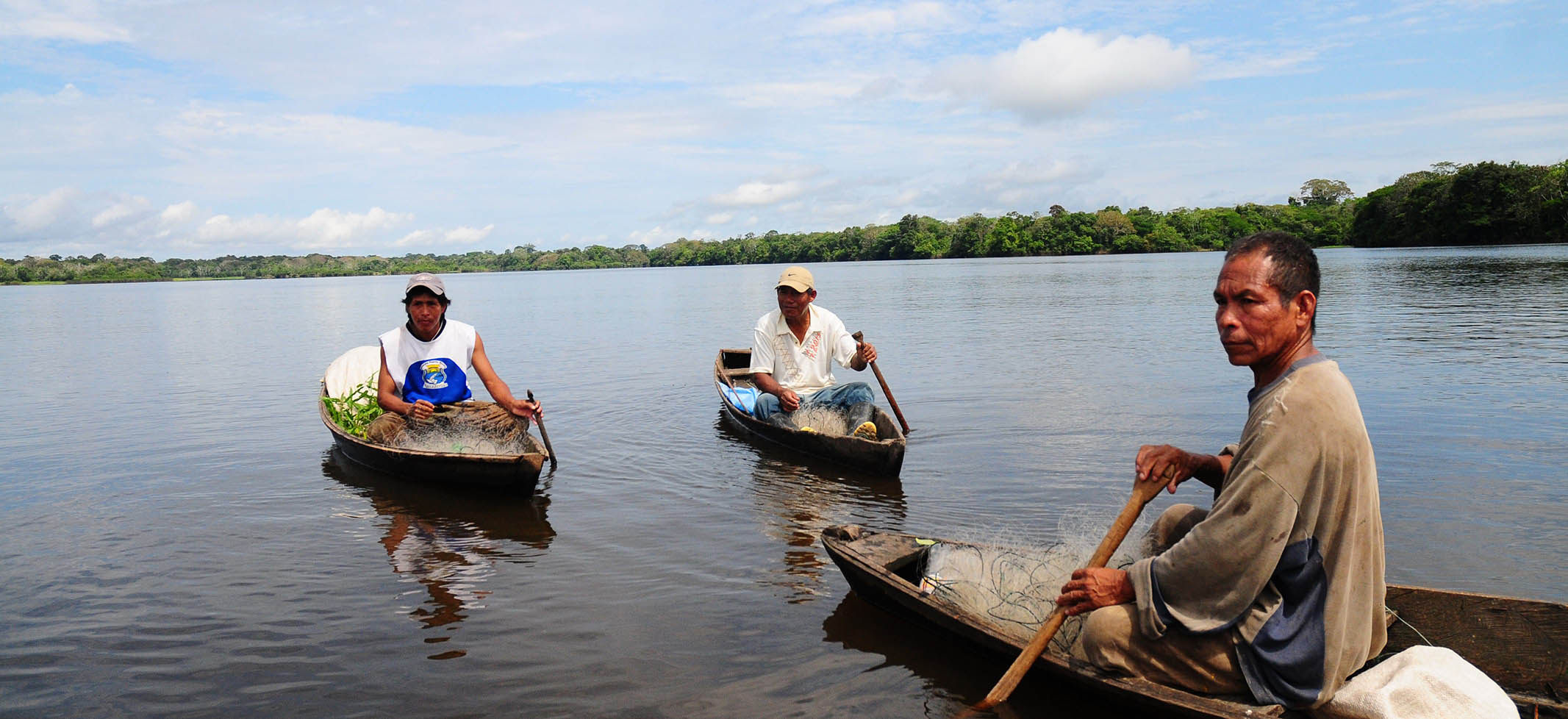
© Fundación Omacha/Fernando Trujillo.
2. LOCAL DEMOGRAPHICS AND SOCIAL ORGANIZATION
Puerto Nariño has a total population of 6 983 inhabitants, of which 1 848 live in the urban area and 5 135 live in the rest of the municipality, according to the latest census of 2005 carried out by the National Administrative Department of Statistics (DANE, 2010).34 Over the past 20 years, the population growth rate of Puerto Nariño has been 53 percent, with a birth rate of 28 per 1 000 inhabitants, exceeding the national average of 19 per 1 000 inhabitants (Trujillo and Laiseca, 2016). This growth has been accompanied by socio-cultural dynamics inherent to urban areas, therefore representing a challenge for the municipality’s sustainability. The territory inhabited by the Indigenous Peoples corresponds to the area of the reserve, which is constitutionally defined as:
“areas collectively owned by the indigenous communities, which are inalienable, imprescriptible and unseizable. They are a legal and socio-political institution of a special nature, formed by one or more indigenous communities, which – through collective ownership – enjoy the guarantees of private property, possess their territory and are governed by an autonomous organization protected by indigenous jurisdiction with its own normative system in managing the territory and life within its boundaries” (translated from Ministerio del Interior y de Justicia, 2013).
The Ticoya reserve’s population is distributed amongst 22 communities or settlements. Each community has a leader known as curaca, who is the representative of the settlement or community. The curaca is responsible for the community’s legal affairs and conflict resolutions, as well as for representing the community at the reserve level in decision-making processes. In 2007, the Association of Indigenous Authorities of the Tikuna Cocama and Yagua was created. This association is made up of the 22 curacas as representatives of each community.
As the map shows, the communities are connected to each other along the river. The communities that participated in the profiling work live closest to the Tarapoto Largo and Tarapoto Redondo lakes, which are part of the Lagos de Tarapoto Wetlands Complex. They are recognised as ecosystems of great importance in terms of food, as they contain large stocks of fish. It is important to mention that aquatic ecosystems are crucial for these Indigenous Peoples as they symbolize their culture and way of life. For instance, the Tikuna people’s stories about the origins of life tell how the human population comes from the fish that Yo’i – the father creator of the Tikuna – caught from the water and transformed into the first settlers.

The population of Puerto Nariño is mostly Tikuna, followed by the populations of Cocama and Yagua peoples. The most spoken language is Spanish, although each Indigenous People have their own native language that are of the same name – the Tikuna, the Cocama and the Yagua. As the Tikuna people comprise the majority, their language is the second most spoken in the reserve. The Cocama and Yagua languages are mostly spoken by the elders. Children and youth speak mostly Spanish in their daily lives as they use it in schools and colleges. Additionally, the Colombian educational system provides some basic English teaching, mainly motivated by the increasing tourism in the area that provides job opportunities, especially to the youth. The younger generations learn the Tikuna, Cocama and Yagua languages from their parents or grandparents.
Households consist of a nuclear family composed of the mother, the father, children and – in some cases – grandparents. The organisational structure of the population is strongly related to nature. The population is grouped into clans, which – in the case of the Tikuna people – have animal names, differentiating between air and land animals. The Tikuna people35 have patrilineal relationships, where the male children inherit the clan from their father. In turn, the clans are exogamous, as unions were only formed between members of different clans. Nevertheless, at present, marriage is not strictly limited by clan, as the population today is the result not only of unions amongst the indigenous groups in the reserve but also between them and the settlers. The latter come from the rest of Colombia and from neighbouring countries. For this reason, it is possible to find families whose members speak Portuguese.
Despite the presence of Catholicism and Christianity, the communities’ members do not identify with a dominant religious identity and there is no representative religious figure in the leadership of the participating communities. Their internal organization is determined by the Life Plan (Asociación de Autoridades Indígenas del Resguardo Tikuna-Cocama-Yagua, 2007), a document that reflects the population’s thoughts on their identity and culture. It is used as a tool for planning their own development and public management through an indigenous political project. It constitutes a comprehensive proposal to ensure the way of life, continuity and survival as Indigenous Peoples. Some of the principles of the Life Plan are:
• respect and recognition for elders who are knowledge holders and for traditional authority figures as natural advisers.
• the Wone Congress36 is recognised as the highest authority in the Ticoya reserve and its mandates as law within the territory of the reserve. The members of the Wone Assembly are mostly elected through a vote within each community.
• the Indigenous Authorities of the Tikuna, Cocama and Yagua (ATICOYA) is the Management Board of the reserve. It is recognised as the next-highest authority in the absence of the Wone Congress.
• recognition of the Indigenous Justice Regional Council: it is made up of elders designated by each community as traditional authority figures to exercise and uphold jurisdiction.
• autonomy rests on the collective mandate of the communities.
• the Traditional Authority Figure is composed of elder knowledge holders, shamans or traditional healers who know and understand the laws of nature. They are responsible for guiding, healing, directing and imparting justice in their respective communities.
For this reason, each community has a Council of Elders regulated and recognised by the Community Assembly of the reserve, or the Wone Congress. Such council is made up of the traditional authority figures to uphold indigenous jurisdiction. The elders and shamans or healers are the only authority figure who holds a position that is inherited or acquired by seniority.
3. LOCAL FOOD PRODUCTION
The activities that produce food are farming, fishing, hunting and gathering. All these activities depend on the water and forest systems. They provide not only the food but also any surplus intended for marketing that brings an income for purchasing other products not generated within the system. Therefore, there is a dual system that combines traditional subsistence with the market economy, based on the sale of surplus food at the local market. In addition, there is evidence that the communities’ members are increasingly doing paid work activities that allow them to earn money for the purchase of products and food available in the shops – almost all of which are products not found in the traditional system.
Food can be classified according to the activity of the food system that generates it, such as: harvesting and gathering, live food, and fishing and hunting. It can also be classified according to the area where it is produced or obtained, such as tierra firme, várzea or floodable area, and the time of year, as determined by flood pulses: low waters, rising waters, high waters, falling waters and all year round.
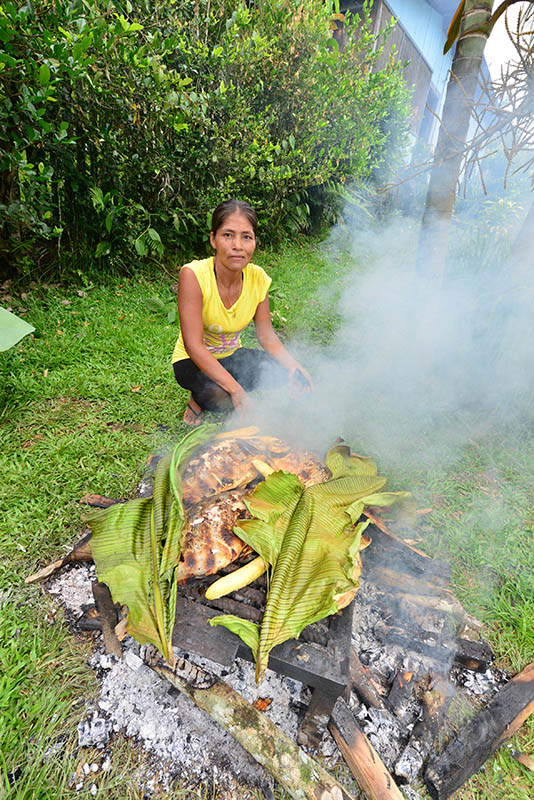
© Fundación Omacha/Fernando Trujillo.
Crops
The community members source their plant edibles from the chagras and the forest (Tables 7.1 and 7.2). The farming activities are carried out in the chagra – the diversified productive system in which annual and perennial species are cultivated and where attempts to reproduce forest succession processes are made. Each family makes the chagras by selecting a specific site in the forest, where they selectively cut and burn trees for the subsequent planting of several species of plants that provide food for the family group. Besides being a food production system, the chagra is also considered a knowledge system for the family, representing the cultural heritage and identity of each family. More than half of the food consumed by the family is produced in the chagras, giving the population a high degree of independence from the market. The chagra production system is considered sustainable because it produces enough per family for self-sufficiency, and chemicals such as fertilizers and pesticides are not used. Most of the products from the chagra are sold at the local market in the urban area or in the ports of each community. Nevertheless, the amounts for sale are the surplus from family production, thus these vary according to the harvesting and gathering periods of each product.
L: low waters; R: raising waters; H: high waters; F: falling waters

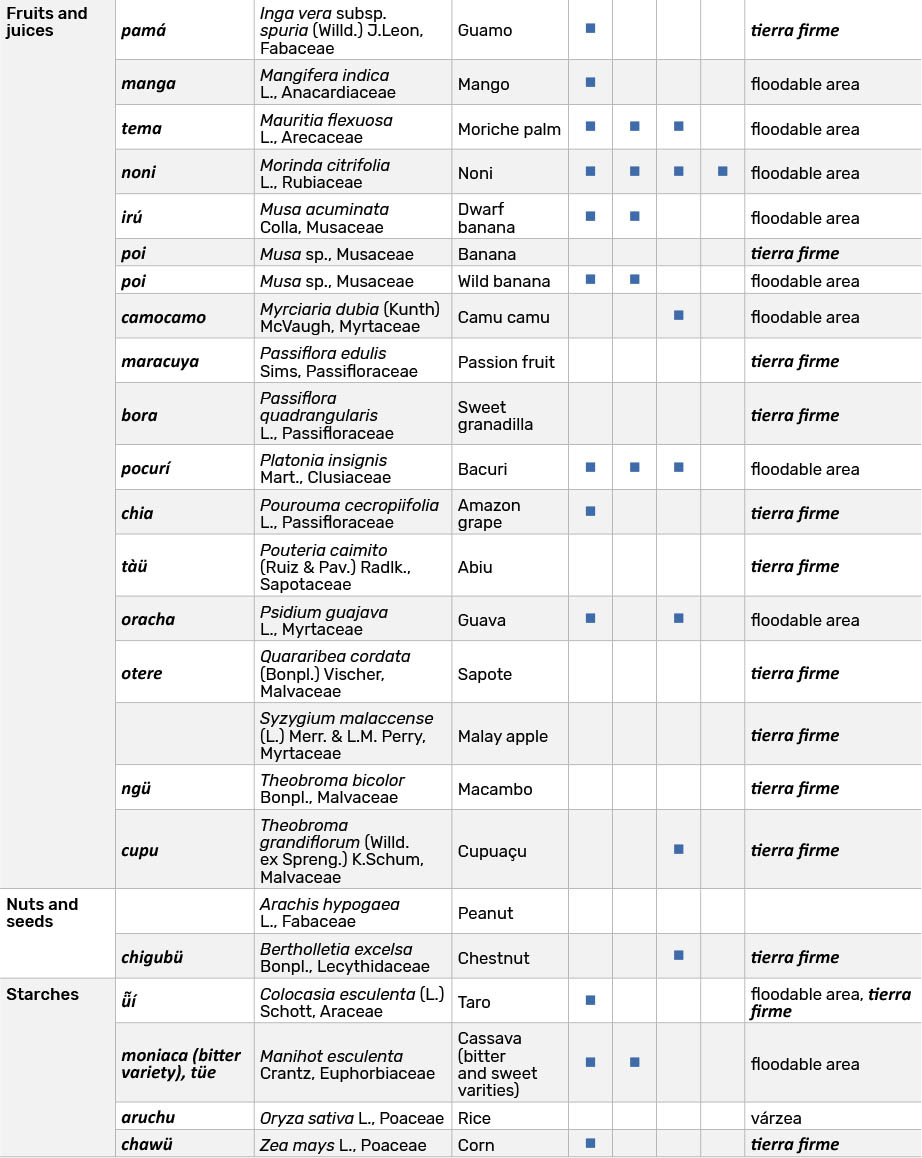

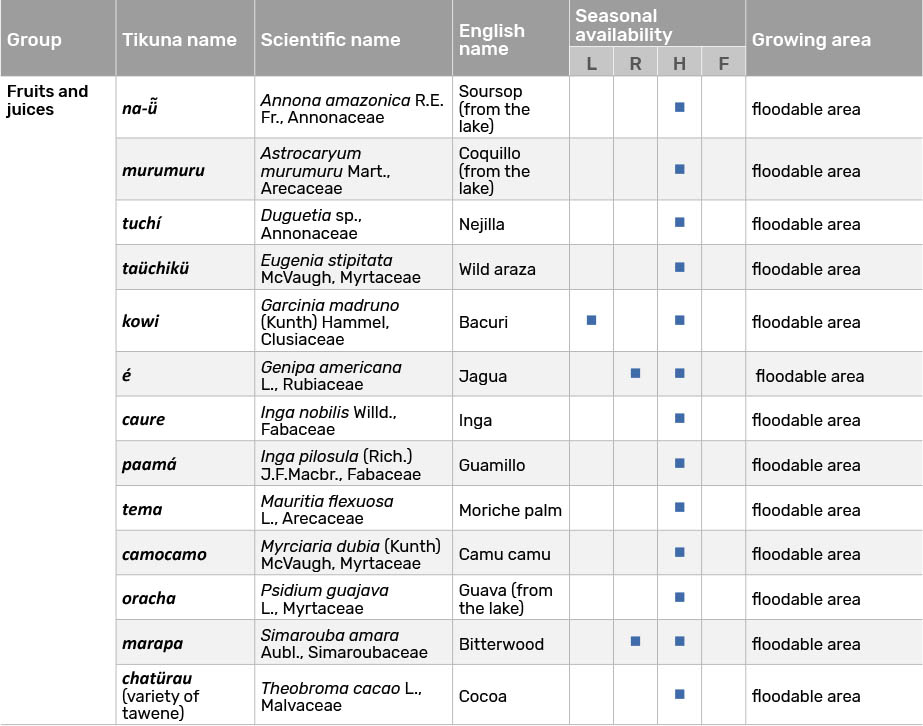
Fishing
Fishing is done in the Amazon and Loretoyacu rivers, and in the Tarapoto Largo, Tarapoto Redondo and El Correo lakes, which are characterised by their high fish availability. Studies carried out by Urbano et al. (2014) identified approximately 68 fish species consumed within the communities. The species consumed the most have been reported during the participatory workshops (Table 7.3).
L: low waters; R: raising waters; H: high waters; F: falling waters
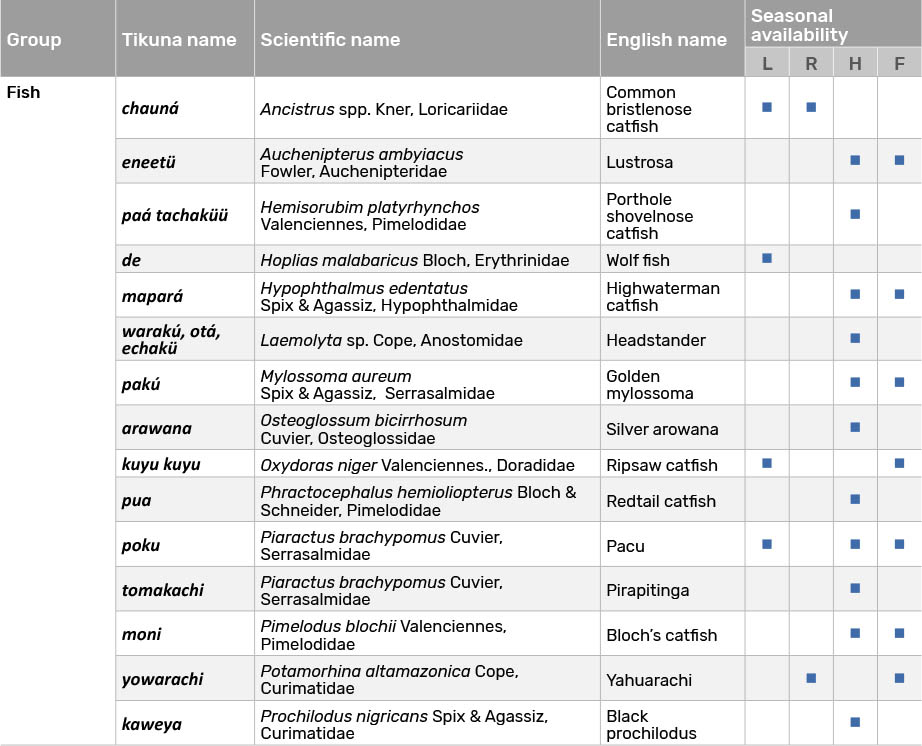

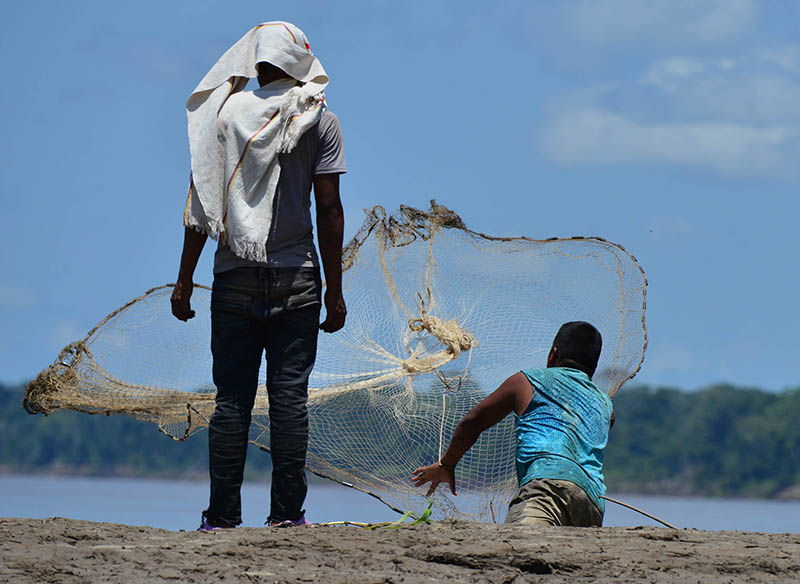
© Fundación Omacha/Fernando Trujillo.
Due to direct interaction with water systems, fishing has always been an important activity, not only for the provision of food but also for the development of the way of life and culture of the Indigenous Peoples. The elders related that in the past, children learned everything related to fishing and the underwater world from their parents. Children spent long hours with their parents learning how to make and handle artisanal fishing gear, such as harpoons, arrows, rods and natural fibre rods.
Traditionally, fishing has been an activity carried out mostly by men, with the Tikuna standing out for their fishing skills. This activity, aside from being a vital way of providing food for the families, is also important as an entertainment activity. Historically, women have always been in charge of post-fishing activities related to the preparation of food for family consumption. With their recent integration into the market economy, the women are now responsible for selling in the market. In all households, at least one male member would go fishing at some time during the year. All households have at least one kind of fishing gear, with nylon nets and hooks as the most common.
Within the community, the inhabitants identified important differences between men who are considered “people who go fishing” and those who are “professional or full-time fisherfolk”. “People who go fishing” refers to any member of the family who goes fishing for a short period of time in places close to the community with little or no mastery of traditional fishing gear, as nylon nets are mainly used. Unlike the former, professional or full-time fisherfolk are men who have great skill and mastery of artisanal fishing gear. They have in-depth knowledge on aquatic ecosystems and the landscape in which the different species of fish and other wetland animals are found, as well as their feeding habits and reproductive characteristics. In addition, this group is more actively involved in the decision-making processes related to fisheries management and ecosystem stewardship. An example of this is the creation of the calendar for responsible fishing, which was prepared by the fisherfolk and elder knowledge holders.
The expert fisherfolk consider themselves to be responsible for the fish supply in their communities. They are also recognised leaders in the fishing industry, a direct consequence of the widespread use of nylon nets, to meet the demand by Pan-Amazonians who began to arrive in the area. This situation led the artisanal fisherfolk to carry out educational work with the younger generations through the Community Fisheries Agreements of 2006 to promote responsible fishing.
Hunting and trapping
Hunting and trapping of forest animals are part of the traditional activities of the food system. At present, these practices remain important subsistence activities that provide for the family within the communities. However, because the carrying of firearms and the selling of bushmeat and wild animals outside the reserve areas is illegal, this activity has significantly decreased. Therefore, when hunters have a surplus, it cannot be sold in Puerto Nariño’s urban area.
This situation, besides decreasing hunting as a practice to provide animal protein to families, has contributed to the gradual loss of the population’s traditional knowledge and customs for obtaining food from nature. Men traditionally practise hunting, generally in groups and with an average frequency of once a week in the case of expert hunters, and twice a month in the case of those who hunt occasionally. Currently, some hunters from the participating communities engage in this activity affiliated with the Airumaküchi Hunters’ Association, which was created by hunters from the different communities aiming to engage in this activity in a responsible manner. Although men traditionally practise hunting, females are not excluded from this activity. They, unlike men who use shotguns and traps, employ dogs.
Hunting takes place in the jungle, in the flooded forest and in areas close to water sources, better known as salt licks. Such places, mainly far from human activity, are the habitat of a large number of wild animals, a reason why communities’ members consider them as sacred areas or sites that deserve special care and protection. Birds and primates are usually hunted close to the lakes and on the riverbanks, whereas middle- and big-sized mammals are hunted on tierra firme. Nga (Cuniculus paca, lowland paca) are hunted in the chagra that they often visit to eat the cassava. The meat is mostly for household consumption, although depending on the size of the animal, it can be sold within the communities to obtain some income. Species such as nga, chigu (Dasyprocta fuliginosa, black agouti), Alouatta seniculus (red howler monkey), ngobü (Chelonoidis denticulatus, yellow-footed tortoise) and nakü (Tapirus terrestris, lowland tapir) are reported to be the most important preys for consumption and commerce in Puerto Nariño (Quiceno, Cruz Antia and Moreno, 2014).
The meat is sold fresh by the kilogram. Hunting products do not generate added value, nor are they transformed into other items. Hunting is not a principal activity, but rather a complementary one to fishing, as it does not represent a significant percentage of the family group’s total income.


4. OTHER LAND-BASED PRODUCTIVE ACTIVITIES
Aside from food production activities, the Tikuna, Cocama and Yagua communities’ members use elements of the ecosystem for their livelihoods. In particular, 28 species of palms have been identified and the category of use has been reported for some of them (Table 7.5). Fourteen of them are used to construct houses, such as timber trees and palm leaves to weave the houses’ roofs (Forero-Tocancipá and Córdoba, 2014). The use of wood for housing construction is a current practice in most of the settlements. However, in the past two years, housing construction projects promoted by the national government have been launched using construction materials. Furthermore, the use of palm leaves to roof houses is becoming less common, as people prefer to use zinc sheet metal for this to avoid the maintenance costs involved in installing palm thatch roofs. Fourteen species have also been identified that are used to elaborate handicraft. Weaving fabrics from natural fibres and carpentry are traditional activities. Commonly, women weave using natural fibres and men make wooden crafts. Nevertheless, nowadays these activities are carried out to sell the products to visitors and tourists. They are driven by government programmes and non-governmental organization (NGO) initiatives to mass-produce their products to promote the generation of income amongst the communities’ population. Thirteen species are used for food, and seven for medicinal uses. Some species can host ngairé (Rhynchophorus sp., palm weevil or mojojoí), which is collected for food (Forero-Tocancipá and Córdoba, 2014). The seeds of annatto (Bixa orellana L., Bixaceae) and jagua (Genipa americana) are used for their pigments and cosmetics by the Tikuna to paint their skin black for celebrations and rituals, giving these fruits a high cultural value.
L: leaves; F: fruit; S: seed; B: bud; T: tronc; R: root; W: palm weewil (mojojoí)

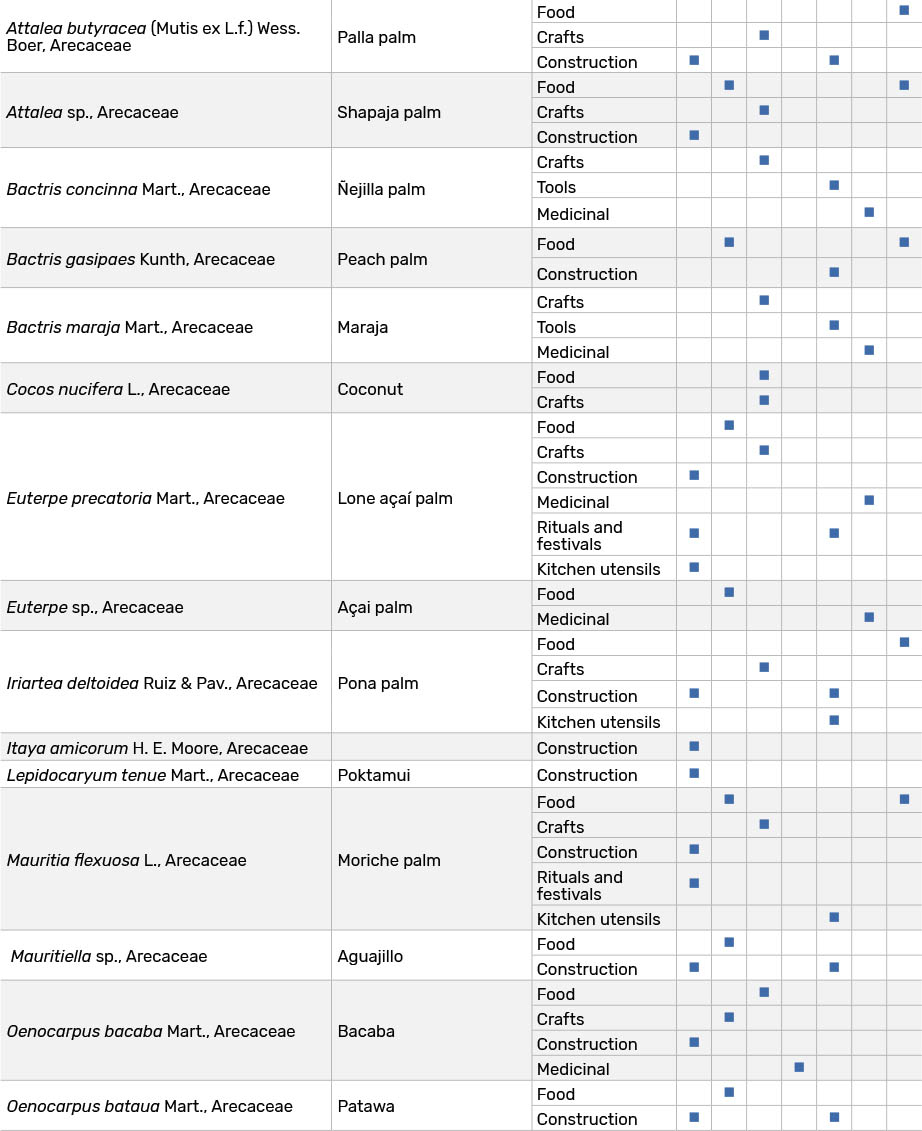

Livestock farming is an activity present in one of the six participating communities. However, it is not a representative activity for the food system, as it was introduced through national rural development initiatives, which the population consider unsuccessful due to low acceptance. The raising of some animal species as a source of food and protein has been identified amongst the practices with less relevance. Such is the case for the raising of chickens, pigs and ducks, from which meat and eggs are derived. Yet, their consumption is not considered significant. These products are mainly intended to either exchange amongst communities or to use as food during celebrations and festivals. Farmyard animals, such as chickens, pigs, ducks and, to a lesser extent, livestock are raised in small areas close to homes, such as backyards or pastures in the case of livestock. Finally, the sources of animal feed and fodder used are those available in the natural environment and organic household waste.
5. LOCAL CALENDAR
Puerto Nariño’s food production calendar shows variations throughout the year due to seasonality, the water levels of bodies of water, changes in the landscape, and the movement and migration of animal species, especially fish.
Flood season takes place at the beginning of the year from February to April. This is the time of year, called high waters, when the water level reaches its maximum height and the blackwater wetlands system is flooded by whitewater from the Amazon River. During this period, the forest is flooded, creating new feeding grounds for fish and giving rise to fishing areas within the forest, as the fish are dispersed along rivers, lakes and forests. This is when the different species of fish begin to spawn and species such as the Amazon river dolphin (Inia geoffrensis Blainville, Iniidae) enter the wetlands in search of food. Flooding fertilizes the soils with nutrients, preparing them for planting during the summer. May to July is the time of falling waters. The water level begins to drop, forcing many fish to leave the wetlands for the rivers, following the progressive appearance of tierra firme plains. The period of low waters begins in August and goes until October. The water reaches its lowest level, giving rise to sandy beaches and exposing tierra firme forests, whilst disconnecting the lakes from the rivers. This is when the presence of land mammals in the forest becomes evident. During this period, people fish more, as many fish that do not head towards the rivers become trapped in the lakes, making it easier to catch them. In the low water periods, paths providing access into the forest open up, making it easier for hunters to enter in search of land mammals or birds that provide them with animal protein. Food crops such as fruit trees and cassava (Manihot esculenta) are planted during this period. From November to January, the rising waters correspond with the Amazon River once again flooding the forests and wetlands system, marking the beginning of the flooding cycle. During this time, trees bloom, the fish begin to spawn and the fry are born. Fish enter the lagoon system as feeding sites for fish appear.

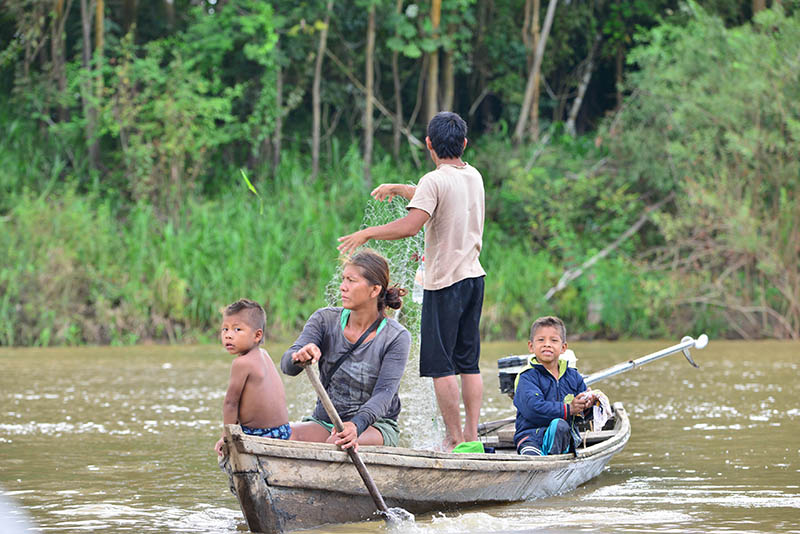
© Fundación Omacha/Fernando Trujillo.
6. MARKET SOURCING AND TRADE
Puerto Nariño has three main stores or local markets where the communities’ members buy food as part of their diets. Primarily rice, oil, meat, frozen chicken,37 beef, coffee and salt are sold, as well as processed foods such as pasta, sugar, panela, wheat flour, bread, canned sardines, dairy products, alcoholic beverages, soft drinks and sweets. Most of the products available at these stores are Peruvian and Brazilian brands, especially dairy products, canned meats and frozen chicken.
The stores are open daily. Nevertheless, the population living in the communities usually do their shopping on weekend mornings and buy a small proportion of all the food they consume at these markets as the rest is produced in the chagras. This is particularly true for families of fisherfolk that also have access to a chagra as they have greater independence from the market in terms of obtaining food. Lastly, as there is no packaging system within the food system for fresh foods such as fish, the pulp of ripe fruit and bushmeat, any surplus production is sold as fresh products at the local market on the same day it is obtained. Other products such as tubers and some green fruits for ripening, such as bananas (Musa sp.) or wild bananas (Musa acuminata), are brought to the market on a weekly basis.
7. COMMUNITY HISTORY AND FOOD SYSTEM TRANSITIONS
Due to the wealth of natural resources of the Amazon ecosystem, the population has historically faced various highly complex socio-economic and cultural processes. Similar to other areas of the Colombian Amazonian region, there have been several extractive bonanzas based on the exploitation and use of plants and animals in this area. Puerto Nariño was recognised as a corregimiento38 in 1961 to guarantee national sovereignty, as it did not have the number of inhabitants required to achieve municipality status at that time. It was only in 1984 that Decree No. 0106 of January 18 granted the status of municipality to Puerto Nariño. However, according to participants, due to population growth, evangelization and the arrival of missionaries around 1970, the population was grouped into 22 communities, which eventually became the settlements comprising the reserve today.
Throughout the history of the settlements’ process, the region’s natural and weather conditions reflected in the dynamics of the aquatic ecosystems and the levels of the bodies of water have had a huge impact on the settlements’ geographical location, the peoples’ way of life and food production. For instance, people migrate from floodable areas to tierra firme areas in search of a location that guarantees proximity to the river to carry out activities such as fishing, yet at the same time to ensure that houses are not susceptible to annual flood pulses. Another example is the community of Santa Clara de Tarapoto, located in a floodable area. Although important efforts are needed to maintain houses on stilts during periods of flooding, inhabitants benefit from having more fertile soils. These fertile soils are particularly exposed during the low-water period, and become the perfect sites to grow products such as cassava, some vegetables and fruit trees for human consumption and fish food. Consequently, such grouping processes gave rise to most of the rapid changes and modifications in the ways of life of the Indigenous Peoples.
Another important phenomenon was the process of evangelization of the Indigenous Peoples through the educational system and the imposition of the Spanish language by the missionaries and nuns of the Catholic Church. Indigenous Peoples were not allowed to speak their own languages and they would suffer physical punishment for doing otherwise. An important step forward was Resolution No. 21 of March 13, 1990, which allowed for the legal recognition of collective property rights to the Tikuna, Cocama and Yagua peoples. This was made possible with the recognition by the 1991 Political Constitution of Colombia that granted political, administrative and financial autonomy to Indigenous Peoples (see Political Constitution of Colombia, 1991, articles 286, 287, 328, 329). As a result, the elders noted that by the end of 1990, the restrictions on speaking their own languages were finally lifted. Nevertheless, participants pointed out that the period in which the restriction on speaking their own languages was in force was enough to weaken the younger generations’ learning of these languages. Consequently, the traditional practices associated with their ways of life, which are highly dependent on oral tradition, were likewise weakened.
As a result of the rooted impositions made by the institutional educational system and the colonization processes over the past 50 years, during which the indigenous population was forced to use Spanish, Indigenous Peoples continue articulating their traditional ways of life but now within the context of the market economy. Such conditions give rise to new needs and consumption habits, for which it became necessary to generate income to meet them.
Although the production of food in chagras has remained the primary activity for the provision of food along with fishing and to a lesser extent hunting, techniques and products generated from these activities have significantly changed over time. For example, particularly from the 1980s onward, many seeds were introduced, coinciding with the establishment of Puerto Nariño as a municipality and urban area, and the subsequent arrival of State institutions. Such administrative organizations promoted productivity based on new seeds, especially vegetables, as well as aromatic and spice plants.
Likewise, the creation of the urban area increased the arrival of processed products to the markets, changing the population’s eating habits with the inclusion of fried foods, processed foods and alcoholic drinks that replaced the fermented cassava chicha. The consumption of frozen chicken from urban markets has become ubiquitous, as the price of chicken from Brazil is lower than the price of fish. Fishing intensification using nylon nets and hunting nets increased extraction pressure, deeply affecting hunting and fishing. The critical state of fisheries gave rise to the Community Fisheries Agreements as a sustainable use strategy (Trujillo, Escobar and Trujillo, 2017). Finally, the fishing crisis brought about a change in consumption habits. Previously, only adult fish and large fish were caught, and fishing operations were more rapid. At present, endemic fish species are scarce and difficult to catch. Fisherfolk devote more hours to fishing and it is common for their catch not to feed the family enough. The use of nylon nets has become a widespread practice.
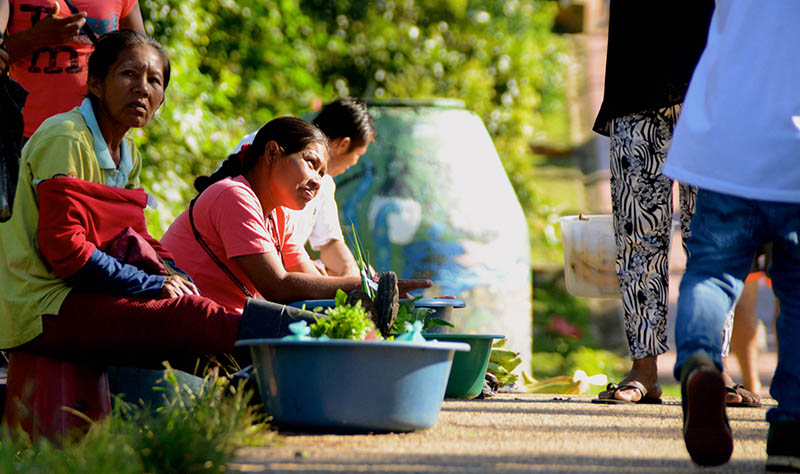
© National University of Colombia/Daniel Baena.
- 33 These forests are located on plateaus (60-200 m) and on well-drained soils. Such lowland forest is characterised by a dense and uniform cover formed by trees of 30-40 m in height, which creates a humid and shady habitat that hosts a high diversity of species with a high density of individuals (Portaccio, 2013).
- 34 The most recent census in Colombia was carried out in 2018. The current demographic data are not available as of now; however, DANE forecasts 8 519 inhabitants for 2018.
- 35 As the Tikuna people are the majority of the Ticoya reserve and consituted most of the participants in the discussions, the findings presented in this report are representative of this Indigenous People.
- 36 Wone refers to the name in Tikuna language of the tallest tree in the forest, the ceiba (Ceiba pentandra (L.) Gaertn., Malvaceae).
- 37 “Frozen chicken” is the term used by the participants to name chicken that is not produced within the community. The participants stated that the frozen chicken available at the market is from Brazil, and it is cheaper than the frozen chicken produced in Colombia.
- 38 A corregimiento is an administrative division of the rural area of a municipality, which includes a population core without reaching the category of municipality.
“Producing our food is inherited from our parents, it is respect for nature and its future children.”
Community member and participant to the thematic discussions in Puerto Nariño.
